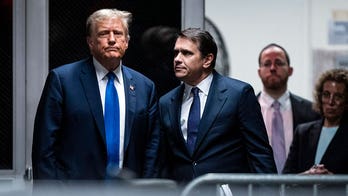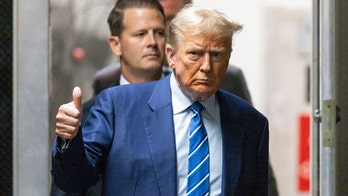The Speaker’s Lobby: On a June day in 1987, Ronald Reagan stood before a crowd at the Brandenburg Gate. The Berlin Wall snaked behind him, the most-iconic symbol of the Cold War.
This is where the President of the United States demanded action from the General Secretary of the Soviet Union.
“Mr. Gorbachev, tear down this wall,” Reagan ordered.
Mikhail Gorbachev didn’t. But a little more than two years later, “this wall” buckled under the political pressure of an evolving Eastern Europe. It liberated half a continent from Communism.
And now some chips of “this wall” are memorialized inside the U.S. Capitol. They’re part of a tribute to the man who uttered those fabled words.
Ronald Wilson Reagan, the fortieth President of the United States, took his place in the Capitol Rotunda Wednesday in the form of a seven-foot, bronze statue. Chocolate in tone, Reagan looms across a foyer from a statue of President Dwight Eisenhower and next to a painting that depicts Christopher Columbus’s landing in the West Indies in 1492.
Reagan’s sculptor, Chas Fagan, embroidered the top of the statue’s base with pieces of the Berlin Wall.
One of Reagan’s hands rests on a shelf, emblazoned with a torch. The presidential seal is embossed on one side of the base. The California state seal adorns the other. A quote from Reagan is inscribed on the back: “Our most glorious achievements just ahead.” Ironically, it’s nearly impossible to read because it’s inscribed so low on the base, sandwiched between the statue and the wall.
Late Wednesday morning, hundreds of people filled the Rotunda to catch a glimpse of the statue for the first time. House Speaker Nancy Pelosi (D-CA) helped Reagan’s 87-year-old wife Nancy struggle to her feet to unveil the statue. With assistance, Reagan tugged back a blue drape cloaking her bronzed husband. Mrs. Reagan called it “a wonderful likeness of Ronnie. He would have been so proud.”
Reagan Chief of Staff James Baker told the crowd that Reagan’s statue now “will stand forever as a silent symbol to inspire.”
It took an more than an hour for the throng to filter out of the Rotunda. Afterwards, many of the dignitaries on hand for the ceremony clamored for a closer glimpse of the statue. Some even posed for a picture with the Gipper. Almost all of them crouched down to see and touch the bits of the Berlin Wall. They traced their index fingers across the jagged fragments, ensconced in the base. Fragments, that when fused together, formed a barrier that preserved dictators and oppressed millions of people trapped on the other side.
You see, every state gets two statues. Most of them reside in Statuary Hall, the old House chamber or the Capitol Visitor’s Center. Every Vice President (who the Constitution, dictates, is the President of the Senate) receives a bust in the corridors circling the Senate chamber. There are various paintings strewn throughout the Capitol complex. Some in back hallways. Others in dank committee rooms. They depict everyone from former House Speaker Newt Gingrich (R-GA) to the late Rep. Shirley Chisholm (D-NY), the first African-American woman to serve in Congress.
But the prime real estate for statues and paintings is the Capitol Rotunda.
So I decided to check out the newest exhibit in nation’s most prominent art gallery around 9:30 pm Thursday.
One of my favorite things to do in Washington is to sit quietly in the Rotunda at night. I took a seat on a bench next to Reagan’s statue. The Capitol was silent. And I just sat and stared around the room, wondering how Reagan would get along with his Rotunda peers.
Staring down at Reagan and his colleagues from the canopy of the towering Rotunda is a mural titled “The Apotheosis of George Washington.” It depicts President Washington rising into heaven, framed by two goddesses and 13 maidens. On the ground, Reagan stares directly across the room at a statue of Abraham Lincoln. Ringing the Rotunda are Alexander Hamilton and Ulysses S. Grant. To Reagan’s right is the “Portrait Monument,” a gigantic statue of the figures behind the women’s suffrage movement: Lucretia Mott, Susan B. Anthony and Elizabeth Cady Stanton. Andrew Jackson guards one door. Thomas Jefferson minds another.
Ringing the Rotunda walls are hulking, 12 by 18 feet paintings depicting some of the most famous scenes in American history: The Signing of the Declaration of Independence, the Embarkation of the Pilgrims, Washington Resigning his Commission, The Baptism of Pocahontas and the Discovery of the Mississippi among them.
I sat alone for quite a while. But then a band of teenage House pages skipped into the Rotunda, giggling. They immediately plopped down in the center of the room. Unaware I was sitting nearby, the pages laid on their backs, staring toward the top of the Capitol Dome. Another page snapped a few pictures of his colleagues, sprawled right in the middle of the Rotunda where Reagan, President Ford and Lincoln all laid in state. I’m told this exercise is a tradition for House pages. The group then galloped over to snap a few pictures of the Reagan statue.
And that’s when they spotted me sitting on the bench.
The foursome was startled at first. Then chagrined after realizing I witnessed their after-hours shenanigans. But I didn’t care. I asked them what they thought of Reagan and showed them the thin line of Berlin Wall remnants, stuffed into the base.
They all touched it. “Wow!” exclaimed one. “Cool!” said another. I asked if they knew why the artist included pieces of the wall.
“Because the wall fell when he was president,” answered one.
Wrong.
“This wall” came down under the watch of Reagan’s successor, President George H.W. Bush. And that’s when I realized that Reagan’s statue was truly right at home among the artwork and statuary of the Capitol Rotunda.
You can find three common denominators among much of the Rotunda’s collection. One is historical inaccuracy. The second other is the distillation of an event or person into a Wikipedia headline. The third is propaganda.
For instance, the painting of the Declaration of Independence is probably the most famous image in American history. It features John Adams, Benjamin Franklin and John Hancock and other signers of the declaration at Philadelphia’s Independence Hall on July 4, 1776. Never mind that people didn’t start signing the document until early August. One signer didn’t even sign until 1777. And the scene depicted seems to reflect a June 28, 1776 meeting between Jefferson, Franklin, Adams and others.
As for the Discovery of the Mississippi, never mind that conquistador Hernando de Soto is just the first European settler to find the Mississippi. Choctaw Indians probably “discovered” the Mississippi hundreds of years before DeSoto.
The painting of General George Washington resigning his military commission shows his wife Martha Washington and grandchildren watching. No ever talks about the fact that women and kids weren’t allowed in the room.
Even though the painting of Christopher Columbus is clear he landed in what is now the Bahamas, most visitors walk away believing it shows him “discovering America.” And of course, there’s nary a mention of the Norse explorer, Leif Ericson who set sail hundreds of years before Columbus. And for the record, Ericson didn’t wind up in what is now the United States, either. He made it to Newfoundland.
The Baptism of Pocahontas represents the effort by the colonists to persuade Native Americans to convert to Christianity.
Tourists often decant the statues into factoids. Lincoln “freed the slaves” and Washington was “the father of our country.”
One of my favorite misrepresentations surrounds the Portrait Monument of the suffragists. Some people derisively refer to it as the “Three Ladies in the Bathtub.” That’s because the busts of the three sculptured women appear to float just above a “water line” before disappearing into an immense slab of marble at the base. Rising behind Susan B. Anthony and Elizabeth Cady Stanton rises an uncut chunk of marble. I’ve heard many a lawmaker and Congressional aide tell unsuspecting tourists that there’s a plan to chisel someone’s likeness into the untouched portion. They’ve mentioned everyone from Pelosi to Secretaries of State Hillary Rodham Clinton and Condoleezza Rice. These days, I periodically hear Michelle Obama mentioned.
So, back at the bench, I talked to the pages for a few minutes about Reagan. I told them about his massive military buildup which basically forced the Soviet economy to spiral out of control in an effort to keep up with the U.S. I talked about his plans for a missile defense system, known as “Star Wars.” I told them many applaud Reagan’s policies for helping halt the Cold War a few years after he left office, hence the Berlin Wall pieces. But I noted that many will still debate Reagan’s legacy, despite the prominent placement of his statue in the Capitol Rotunda.
So in the years to come, the tourists will come and run their fingers across the pebbly pieces of “this wall” tucked in the base of Ronald Reagan’s statue. Sure, Reagan’s exhortation to Gorbachev may have hastened the demise of the Berlin Wall. But I’d be curious to revisit Reagan’s statue in a hundred years. Or even ten minutes. I can only imagine how many will leave the Rotunda believing that “this wall” fell during Reagan’s presidency.
- Chad Pergram covers Congress for FOX News. He’s won an Edward R. Murrow Award and the Joan Barone Award for his reporting on Capitol Hill. Inside the Capitol, the Speaker’s Lobby is a long, ornate hallway that runs behind the House chamber where lawmakers, reporters and aides often congregate during votes.




